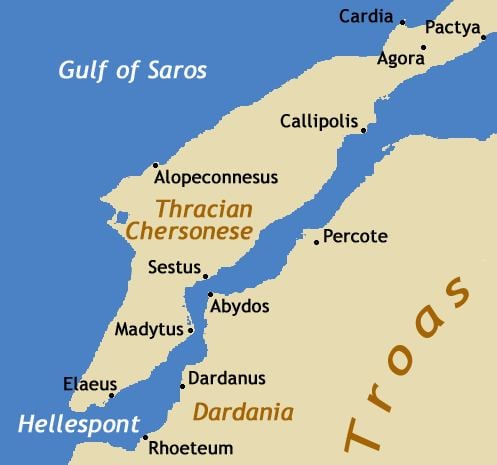Type Settlement | Region Troad | |
 | ||
Weather 7°C, Wind SW at 3 km/h, 100% Humidity | ||
Abydos (Ancient Greek: Ἄβῡδος) or Abydus, an ancient city at Troad (Troas), in Asia Minor was located on the western slope of the promontory south of Nağara Point, and is sited on the best harbor on the Asiatic shore of the Hellespont. The acropolis of Abydos stood on the hill of Mal Tepe. Sestus lies north across from Abydos, on the European side of one of the narrowest points of the Dardanelles, slightly more than a nautical mile (1.9 km; 1.2 mi) broad; the narrowest point is at Çanakkale. The site is enclosed in a military zone considered to be of strategic importance, and access to it throughout the 20th century was generally prohibited.
Abydos was first mentioned in the catalogue of Trojan allies. Strabo, noting that earlier the area was Thracian, states that the city itself was founded by Milesian colonists with the consent of Gyges, king of Lydia, around 700 BC. It was occupied by the Persians in 514 BC, and Darius the Great burnt it in 512 BC. Here Xerxes built two pontoon bridges and crossed the strait in 480 BC, when he invaded Greece. It later was a member of the Delian League.
Abydos is celebrated for the vigorous resistance it made against Philip V of Macedon in 200 BC. In literature, it is famous for the mythical home of Leander. Lord Byron memorably adopted its name in his The Bride of Abydos. It minted coins from the early 5th century BC to the mid-3rd century AD.
The town remained until late Byzantine times as an important toll and customs station of the Hellespont, its importance thereafter being transferred to the Dardanelles, after the building of the "Old Castles" by Sultan Mehmet II (c. 1456).
Bishopric
The bishopric of Abydus in the Roman province of Hellespontus appears in all the Notitiae Episcopatuum of the Patriarchate of Constantinople from the mid-7th century until the time of Andronicus III (1341), first as a suffragan of Cyzicus and then from 1084 as a metropolitan see without suffragans. The earliest bishop mentioned in extant documents is Marcianus, who signed the joint letter of the bishops of Hellespontus to Byzantine Emperor Leo I the Thracian in 458, protesting about the murder of Proterius of Alexandria. A letter of Peter the Fuller (471–488) mentions a bishop of Abydus called Pamphilus. Ammonius signed the decretal letter of the Council of Constantinople in 518 against Severus of Antioch and others. Isidorus was at the Third Council of Constantinople (680–681), Ioannes at the Trullan Council (692), Theodorus at the Second Council of Nicaea (787). An unnamed bishop of Abydus was a counsellor of Emperor Nicephorus II in 969. No longer a residential bishopric, Abydus is today listed by the Catholic Church as a titular see.
